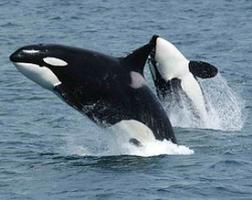 The resident orcas of the Salish Sea are dying. They now number only 75, a 30-year-low. They are being starved as their primary prey, the Chinook, or king salmon, are dying off. They are also being poisoned by pollutants in their waters and hurt by noise pollution from ships and boats. For the last three years, not one calf has been born to the three orca pods in the Salish Sea They have been listed as endangered in both the U.S. and Canada since 2005, but little has been done to reverse their steady decline.
The resident orcas of the Salish Sea are dying. They now number only 75, a 30-year-low. They are being starved as their primary prey, the Chinook, or king salmon, are dying off. They are also being poisoned by pollutants in their waters and hurt by noise pollution from ships and boats. For the last three years, not one calf has been born to the three orca pods in the Salish Sea They have been listed as endangered in both the U.S. and Canada since 2005, but little has been done to reverse their steady decline.
There are three distinct groups of orcas, also known as killer whales, on the coast of the Pacific Northwest. Two groups of orcas referred to as residents, eat almost exclusively fish and return to the same areas immediately along the coast year after year. They are divided into Northern and Southern groups.
The Southern resident orcas, commonly referred to as the orcas of the Salish Sea, live in the coastal waterways in the southwestern portion of the Canadian province of British Columbia and the northwestern portion of the U.S. state of Washington, including the Strait of Georgia, the Strait of Juan de Fuca, and Puget Sound. They reached a peak population of 98 in 1995 and have been declining ever since. There are three Southern resident pods. Since 1998, 40 orca calves have been born to the Southern resident pods and survived, while 72 orcas have gone missing and are presumed dead or have been confirmed to have died.
The Northern resident orcas live off the coast of British Columbia, Canada in coastal waters ranging from mid-Vancouver Island to Southeastern Alaska up through the Queen Charlotte Islands. The Northern resident orcas are thought to number over 300 mammals and have been growing by 2-3% per year. There are 14 Northern resident pods.
While the territories of the Northern and Southern Resident pods overlap, they are not believed to inter-breed.
A third group of orcas referred to as transients or Bigg’s orcas are seen on the Pacific coast from southern California up to the Arctic circle. These orcas travel in smaller pods and eat primarily mammals — seals, sea lions, Dall’s porpoises, harbour porpoises, Pacific white-sided dolphins, gray, minke and other whales.
